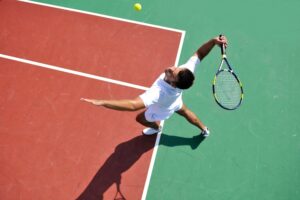Live Ball May Be The Latest Aerobic Trend in Tennis
If you love tennis as much as I do, you are constantly looking for opportunities to get on the court and hit that little yellow ball.
For years, I was chasing fellow players trying to set up regular games, and with everyone’s busy schedule, many times a doubles match was cancelled at the last minute or my singles opponent had to withdraw due to problems at work or home. So when I heard about Live Ball, a fast-paced doubles game where 5 to 8 people could play on a court and you could join in to play and get a great exercise, I was hooked.
This was a few years ago. Now, Live Ball has become a regular part of my weekly schedule. I still enjoy playing doubles or singles whenever I can find willing players and an available court, but to make sure I hit and get my exercise, I play Live Ball.
The Rules
For those of you who are fellow live-ballers, you know what I’m referring. For those who have not yet tried it, here is a description:
The rules of Live Ball are pretty simple. There are always four players on the court at one time – two on the champion side, and two on the challenger side. To displace the champions, the other two players need to win four points. In order to maintain their reign, champions just need to win two. A clean-winner off the feed would result in an instant dethroning of the champions. The first ball is fed by the referee (coach/pro/willing player!), so no time is wasted in-between points for serves to get in. With the ball being fed continually, it forces the players to be constantly on the move. The referee specifies the type of shot off the feed i.e. forehand crosscourt from the deuce court, backhand crosscourt from the ad court, inside-out forehand from the ad court, so on and so forth). The fast pace of Live Ball forces players to anticipate the direction and type of shot for the first ball, allowing them to develop control. In addition, players spend half of their time at the net which helps them improve their net-game and reflexes by decreasing their reaction time.
This game has been described as tennis crossed with aerobics class, but it really is much more than that. Live Ball is like a videogame; it is a unique experience made for the smartphone generation and millennials who also like to also stay active.
As more and more people are moving towards healthier and more active lifestyles, it is no surprise that Live Ball is catching on. What better way to burn calories, have fun and meet new friends?
That is why TennisPAL hosts Live Ball events.
Live BAll is a fun way to stay fit and build a community with people who love tennis. Get invited to these exclusive events only through the TennisPAL app.
Becoming a part of the TennisPAL community is simple. Download the TennisPAL app in the Apple App Store or Google Play Store and sign up. In the app, you can find people who are close to you for a fun tennis game or coaching session. Explore the community and connect with people in our moments feed on and off of the court. Catch up on the latest news from tournaments and rankings. TennisPAL is the active community of tennis aficionados that you have been looking for.
So come join us to meet friends, have fun, and stay fit! We’ll help keep you on your feet. Gear up and we’ll see you on the court!
Download TennisPAL to play Live Ball












I would like to know about Tennispal – especially to start with liveball
thank you
We are having a Live Ball event in 2 weeks. Trying to become familiar with the rules.
With 6 players, do you always end up playing with the same partner?
Or do individuals get bumped off ?
If you miss the feed, does that player bump off or the entire team.
Just trying to figure out how you can end up playing with different partners.
When there is an even number of players, there is a greater chance of getting stuck with the same partner. That said, if the player receiving the first feed misses, they have to return to the end of the same line. Only the person who missed is bumped off and loses that turn. That player has to start at the end of the line (on the same side). The person at the net stays and plays with the next player in line.